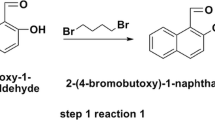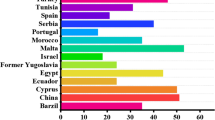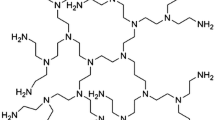Abstract
Dichlorophen (Dcp), a harmful environmental pollutant, is broadly utilized in veterinary medications, chemical fertilizers, pesticides, cosmetics, and personal care products. The current work reports a low-cost, simple, and convenient technique to achieve an electrochemical sensor relying on the electropolymerization of poly-L-arginine (PLA) on carboxyl-functionalized graphene oxide (COOH-GO)–modified GCE for the detection of Dcp. The stepwise assembly procedure and electrochemical characteristics of the fabricated sensor were studied by FTIR, FESEM, EIS, and CV. The resulting PLA/COOH-GO-modified electrode showed a well-defined irreversible peak to Dcp with a broad linear range over 0.01–1.5 and 1.5–60 µM with a low detection limit of 3 nM. Finally, the fabricated sensor was successfully utilized for the quantitation of Dcp in spiked river water with satisfying results. This sensor also displayed desirable anti-interference performance and long-term stability.








Similar content being viewed by others
References
Gan T, Li J, Li H, Liu Y, Xu Z (2019) Synthesis of Au nanorod-embedded and graphene oxide-wrapped microporous ZIF-8 with high electrocatalytic activity for the sensing of pesticides. Nanoscale 11(16):7839–7849
Xie Y, Tu X, Ma X, Xiao M, Liu G, Qu F, Dai R, Lu L, Wang W (2019) In-situ synthesis of hierarchically porous polypyrrole@ ZIF-8/graphene aerogels for enhanced electrochemical sensing of 2, 2-methylenebis (4-chlorophenol). Electrochim Acta 311:114–122
Xie Y, Tu X, Ma X, Fang Q, Lu L, Yu Y, Liu G, Liu C (2019) High-performance voltammetric sensor for dichlorophenol based on β-cyclodextrin functionalized boron-doped graphene composite aerogels. Nanotechnology 30(18):185502
Lone MI, Nabi A, Dar NJ, Hussain A, Nazam N, Hamid A, Ahmad W (2017) Toxicogenetic evaluation of dichlorophene in peripheral blood and in the cells of the immune system using molecular and flow cytometric approaches. Chemosphere 167:520–529
Shi H, Peng J, Li J, Mao L, Wang Z, Gao S (2016) Laccase-catalyzed removal of the antimicrobials chlorophene and dichlorophen from water: Reaction kinetics, pathway and toxicity evaluation. J Hazard Mater 317:81–89
Escalada JP, Arce VB, Porcal GV, Biasutti MA, Criado S, García NA, Mártire DO (2014) The effect of dichlorophen binding to silica nanoparticles on its photosensitized degradation in water. Water Res 50:229–236
Vidal-Limon A, García Suárez PC, Arellano-García E, Contreras OE, Aguila SA (2018) Enhanced degradation of pesticide dichlorophen by laccase immobilized on nanoporous materials: a cytotoxic and molecular simulation investigation. Bioconjug Chem 29(4):1073–1080
Ghauch A, Tuqan A (2009) Reductive destruction and decontamination of aqueous solutions of chlorinated antimicrobial agent using bimetallic systems. J Hazard Mater 164(2–3):665–674
Shi H, Wang G, Huang Q, Li J, Yang Y, Gao S, Wang Z (2018) The mutual promotion of photolysis and laccase-catalysis on removal of dichlorophen from water under simulated sunlight irradiation. Chem Eng J 338:392–400
Guo J, Chen H, Wei X (2019) Thermally sensitive molecularly imprinted polymers on mesoporous silica nanospheres: Preparation, characterization, and properties as novel adsorbents for dichlorophen. J Chem Eng Data 64(9):4005–4012
Wei X, Yu M, Guo J (2019) A core-shell spherical silica molecularly imprinted polymer for efficient selective recognition and adsorption of dichlorophen. Fibers and Polymers 20(3):459–465
Rostkowski P, Horwood J, Shears JA, Lange A, Oladapo FO, Besselink HT, Tyler CR, Hill EM (2011) Bioassay-directed identification of novel antiandrogenic compounds in bile of fish exposed to wastewater effluents. Environ Sci Technol 45(24):10660–10667
Hill EM, Evans KL, Horwood J, Rostkowski P, Oladapo FO, Gibson R, Shears JA, Tyler CR (2010) Profiles and some initial identifications of (anti) androgenic compounds in fish exposed to wastewater treatment works effluents. Environ Sci Technol 44(3):1137–1143
Li Y, Ye Z, Zhou J, Liu J, Song G, Zhang K, Ye B (2012) A new voltammetric sensor based on poly (L-arginine)/graphene–Nafion composite film modified electrode for sensitive determination of Terbutaline sulfate. J Electroanal Chem 687:51–57
Sipa K, Brycht M, Leniart A, Urbaniak P, Nosal-Wiercińska A, Pałecz B, Skrzypek S (2018) β–Cyclodextrins incorporated multi-walled carbon nanotubes modified electrode for the voltammetric determination of the pesticide dichlorophen. Talanta 176:625–634
Tu X, Xie Y, Ma X, Gao F, Gong L, Wang D, Lu L, Liu G, Yu Y, Huang X (2019) Highly stable reduced graphene oxide-encapsulated Ce-MOF composite as sensing material for electrochemically detecting dichlorophen. J Electroanal Chem 848:113268
Falina S, Syamsul M, Iyama Y, Hasegawa M, Koga Y, Kawarada H (2019) Carboxyl-functionalized graphene SGFET: pH sensing mechanism and reliability of anodization. Diam Relat Mater 91:15–21
Eltaweil A, Elgarhy G, El-Subruiti G, Omer A (2020) Carboxymethyl cellulose/carboxylated graphene oxide composite microbeads for efficient adsorption of cationic methylene blue dye. Int J Biol Macromol 154:307–318
Vilian AE, Chen S-M (2014) Direct electrochemistry and electrocatalysis of glucose oxidase based poly (l-arginine)-multi-walled carbon nanotubes. RSC Adv 4(92):50771–50781
Ma F, Nian J, Bi C, Yang M, Zhang C, Liu L, Dong H, Zhu M, Dong B (2019) Preparation of carboxylated graphene oxide for enhanced adsorption of U (VI). J Solid State Chem 277:9–16
Anand SK, Mathew MR, Radecki J, Radecka H, Kumar KG (2020) Individual and simultaneous voltammetric sensing of norepinephrine and tyramine based on poly (L-arginine)/reduced graphene oxide composite film modified glassy carbon electrode. J Electroanal Chem 878:114531
Yi W, He Z, Fei J, He X (2019) Sensitive electrochemical sensor based on poly (L-glutamic acid)/graphene oxide composite material for simultaneous detection of heavy metal ions. RSC Adv 9(30):17325–17334
Kokab T, Shah A, Iftikhar FJ, Nisar J, Akhter MS, Khan SB (2019) Amino acid-fabricated glassy carbon electrode for efficient simultaneous sensing of zinc (II), cadmium (II), copper (II), and mercury (II) ions. ACS Omega
Khan M, Liu X, Tang Y, Liu X (2018) Ultra-sensitive electrochemical detection of oxidative stress biomarker 8-hydroxy-2′-deoxyguanosine with poly (L-arginine)/graphene wrapped Au nanoparticles modified electrode. Biosens Bioelectron 117:508–514
Hasanzadeh M, Mokhtari F, Shadjou N, Eftekhari A, Mokhtarzadeh A, Jouyban-Gharamaleki V, Mahboob S (2017) Poly arginine-graphene quantum dots as a biocompatible and non-toxic nanocomposite: Layer-by-layer electrochemical preparation, characterization and non-invasive malondialdehyde sensory application in exhaled breath condensate. Mater Sci Eng C 75:247–258
Chandrashekar B, Swamy BK, Pandurangachar M, Sathisha T, Sherigara B (2011) Electropolymerisation of L-arginine at carbon paste electrode and its application to the detection of dopamine, ascorbic and uric acid. Colloids Surf B 88(1):413–418
Ali M, Bacchu M, Daizy M, Tarafder C, Hossain M, Rahman M, Khan M (2020) A highly sensitive poly-arginine based MIP as an electrochemical sensor for selective detection of dimetridazole. Anal Chim Acta 1121:11–16
Cao Q, Zhao H, Yang Y, He Y, Ding N, Wang J, Wu Z, Xiang K, Wang G (2011) Electrochemical immunosensor for casein based on gold nanoparticles and poly (l-Arginine)/multi-walled carbon nanotubes composite film functionalized interface. Biosens Bioelectron 26(8):3469–3474
Imani R, Emami SH, Faghihi S (2015) Nano-graphene oxide carboxylation for efficient bioconjugation applications: a quantitative optimization approach. J Nanopart Res 17(2):88
Chhabra VA, Deep A, Kaur R, Kumar R (2012) Functionalization of graphene using carboxylation process. Int J Sci Emerg Technol 4:13–19
Chang C-K, Wu C-C, Wang Y-S, Chang H-C (2008) Selective extraction and enrichment of multiphosphorylated peptides using polyarginine-coated diamond nanoparticles. Anal Chem 10:3791–3797
Li W, Diao K, Qiu D, Zeng Y, Tang K, Zhu Y, Sheng Y, Wen Y, Li M (2021) A highly-sensitive and selective antibody-like sensor based on molecularly imprinted poly (L-arginine) on COOH-MWCNTs for electrochemical recognition and detection of deoxynivalenol. Food Chem 350:129229
Yi Y, Zhu G, Wu X, Wang K (2016) Highly sensitive and simultaneous electrochemical determination of 2-aminophenol and 4-aminophenol based on poly (l-arginine)-β-cyclodextrin/carbon nanotubes@ graphene nanoribbons modified electrode. Biosens Bioelectron 77:353–358
Rezvani Jalal N, Madrakian T, Afkhami A, Ghoorchian A (2020) In situ growth of metal–organic framework HKUST-1 on graphene oxide nanoribbons with high electrochemical sensing performance in imatinib determination. ACS Appl Mater Interfaces 12(4):4859–4869
Acknowledgements
The authors are thankful to Razi University for the financial support of this work.
Author information
Authors and Affiliations
Corresponding author
Additional information
Publisher's Note
Springer Nature remains neutral with regard to jurisdictional claims in published maps and institutional affiliations.
Highlights
• A simple sensing platform was fabricated for Dcp detection based on the electrodeposition of PLA on COOH-GO/GCE.
• The developed sensor has high sensitivity and a broad linear dynamic range.
• The electrochemical Dcp sensor shows remarkable stability, repeatability, and selectivity.
• It was successfully used for actual river water sample detection by spike recovery analysis.
Rights and permissions
Springer Nature or its licensor (e.g. a society or other partner) holds exclusive rights to this article under a publishing agreement with the author(s) or other rightsholder(s); author self-archiving of the accepted manuscript version of this article is solely governed by the terms of such publishing agreement and applicable law.
About this article
Cite this article
Ebrahimi, P., Gholivand, M.B. Introduction of a new dichlorophen electrochemical sensor relying on the modified glassy carbon electrode (GCE) with carboxyl-functionalized graphene oxide/poly (L-arginine). J Solid State Electrochem 27, 291–300 (2023). https://doi.org/10.1007/s10008-022-05323-7
Received:
Revised:
Accepted:
Published:
Issue Date:
DOI: https://doi.org/10.1007/s10008-022-05323-7




